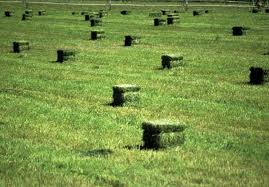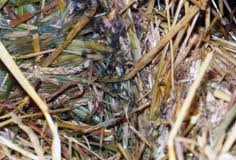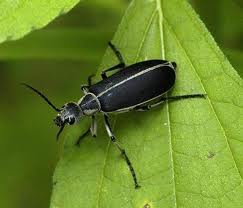|
Hay constitutes a large majority of the horse’s diet

At what stage was the harvest? Nutrient value largely depends on the age at which the hay was harvested. Early maturity produces a product that is very leafy and has a high nutrient density and palatability. With late maturity it contains coarse, thick stems and fewer leaves than with early maturity. Early maturity may be perfect for growing horses and lactating mares, but it may not be the best choice for horses with low nutrient requirements. Mid to late maturity harvest's are best for horses with low nutrient requirements, because the horses can eat more to satisfy their appetites without overeating and becoming fat.
How many leaves and stems are present? Harvesting procedures can affect the leaf content. Excessive movement of the hay during the drying process can shatter the leaves. Overdried it will lose the leaves when baled. Stem content is related to the age at which the plant was harvested. The ratio of stem to leaf increases as age increases so that you get a product that has a higher fiber content.
Are the bales free of dust, mold, and weeds? Clean hay is the best for horses. Mold and dust can inflame the respiratory tract and impair breathing. Many horses can develop permanent lung damage after consuming moldy or dusty hay. Heaves is a common respiratory problem that occurs when a horse consumes moldy or dusty hay. Mold can also cause digestive upsets in the horse. Weeds are undesirable because they are low in digestibility and acceptability by the horse. In some cases they may also be poisonous.
Description and Biology Blister beetles have long (3/4 to 1-1/4 inch), narrow bodies, broad heads, and antennae that are about 1/3 the length of the entire body. The front wings are soft and flexible in contrast to the hard front wings of most beetles.
Three common Kentucky species are: Black blister beetle- jet black
Striped blister beetle- with orange and black stripes on the wing covers
Margined blister beetle- black with thin gray stripe around wing covers
The best way to deal with blister beetles is through management practices that will keep fields from being attractive. If practical, use the first cutting hay for horse feed since the beetles are not active then. The major step is to cut on a schedule that keeps alfalfa and weeds from producing the flowers that attract beetles and keep them in the field. Cut before an advance bloom stage. This produces a product with high quality and protein content and keeps attraction of beetles low. Practice good weed management to keep other flowering plants to a minimum.

Is the hay weathered? Weather conditions can affect hay that is left out in the field to dry after it has been cut. Rain and excessive sunlight reduce the quality by reducing the nutrient content. The ideal moisture content when it is baled is 12 to 18 percent moisture. Excessive moisture due to rain can cause mold when it is baled or processed. Molds commonly found in hay include Alternaria, Aspergillus, Cladosporum, Fusarium, Mucor, Penicillium, and Rhizopus. These molds can produce spores that cause respiratory problems, especially in horses and, under some conditions, will produce mycotoxins.
Horses are particularly sensitive to dust from mold spores and can get a respiratory disease similar to asthma in humans called Recurrent Airway Obstruction (RAO), commonly referred to as heaves. A horse with RAO will have a normal temperature and a good appetite, but will often have decreased exercise tolerance, coughing and nasal discharge. Labored breathing occurs during exercise and, in some cases, while at rest. Hypertrophy of the abdominal oblique muscle used for expiration creates the characteristic ‘heave line’ seen on horses with RAO. Some horses are highly allergic to certain mold spores while others seem to be minimally affected. Even among horses with symptoms of RAO, can be variations of their sensitivity levels to additional detrimental stimuli such as dust and poor air quality. To decrease exposure, horses should spend more time outside on pasture rather than on a dusty paddock or inside the barn.
Additional ways to reduce dust exposure are as follows:
Do not feed dusty and moldy hay and grains.
Use dust free bedding such as shredded paper or rubber mats.
Place feed at a lower level so particles are not inhaled through the nostrils.
Keep your horse out of the stable when you are cleaning and sweeping to reduce exposure to dust.
Feed outside to minimize dust problems.
Soak dusty hay for 5 to 30 minutes before feeding so that the horse can eat it while it's wet.
Store bales away from your horse as much as possible and ensure that they are kept dry to reduce mold.
If the horse is housed indoors, ensure that there is good, draft free ventilation through the stable.
Source - M. Hall
Return from Hay to Horse Riding Connection
|
 insects? Alfalfa may be infected with blister beetles. When a horse eats a blister beetle, a chemical in the beetle causes colic, fever, and eventually death. One major factor that increases potential for blister beetle problems is crimping. This crushes the beetles and leaves them in the bales where they can be eaten by animals. The second factor is a large increase in grasshopper numbers. The larval stages of these blister beetles develop on grasshopper egg pods in the soil. This generally results in increased blister beetle numbers, which in turn increases the potential for contamination.
insects? Alfalfa may be infected with blister beetles. When a horse eats a blister beetle, a chemical in the beetle causes colic, fever, and eventually death. One major factor that increases potential for blister beetle problems is crimping. This crushes the beetles and leaves them in the bales where they can be eaten by animals. The second factor is a large increase in grasshopper numbers. The larval stages of these blister beetles develop on grasshopper egg pods in the soil. This generally results in increased blister beetle numbers, which in turn increases the potential for contamination. 